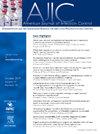Effectiveness of water system chemical disinfection against Pseudomonas aeruginosa infections, despite a not-so-obvious connection
IF 2.4
3区 医学
Q2 INFECTIOUS DISEASES
引用次数: 0
Abstract
Background
Pseudomonas aeruginosa is a well-recognized opportunistic pathogen frequently responsible for hospital-acquired infections. Acquisition routes of P aeruginosa are both endogenous and exogenous, including transmission from a portion of the hospital water system.
Methods
The impact of disinfection procedures of the water system and description routes of P aeruginosa transmission in a surgical intensive care unit over a 2-year period were investigated. Two distinct periods A and B were considered, respectively, before and after the disinfection. Fourier transform infrared spectroscopy was used to compare isolates recovered from patients and tap water.
Results
Overall, 21.3% of tap water samples were positive but with a significantly lower rate in period B. Concomitantly, the prevalence of patients positive for P aeruginosa decreased from 2.6% to 1%, suggesting a correlation between the presence of environmental sources and patient contaminations. The results revealed that 18% of patients were involved in cross-transmission events not related to any isolate recovered from water, suggesting transmission through care practices. Conversely, only 1 environmental transmission event was suspected in a patient.
Conclusions
Although the link between the hospital environment and patients was unclear, HCW-associated care practices could be related to contaminated point-of-use waters and then indirect spreading to patients.
供水系统化学消毒对铜绿假单胞菌感染的有效性,尽管两者之间的联系并不明显。
背景铜绿假单胞菌是一种公认的机会性病原体,经常导致医院感染。铜绿假单胞菌的感染途径有内源性和外源性两种,其中包括从医院供水系统的一部分传播。分别考虑了消毒前和消毒后的两个不同时期 A 和 B。结果总体而言,21.3%的自来水样本呈阳性,但 B 阶段的阳性率明显较低(P< 0.01)。与此同时,铜绿假单胞菌阳性的患者比例从 2.6% 降至 1%(p< 0.01),这表明环境来源和患者污染之间存在相关性。结果显示,18%的患者涉及交叉传播事件,与从水中分离出的任何菌株无关,这表明是通过护理操作传播的。结论虽然医院环境与患者之间的联系尚不明确,但与人机工程相关的护理操作可能与受污染的使用点水有关,然后间接传播给患者。
本文章由计算机程序翻译,如有差异,请以英文原文为准。
求助全文
约1分钟内获得全文
求助全文
来源期刊
CiteScore
7.40
自引率
4.10%
发文量
479
审稿时长
24 days
期刊介绍:
AJIC covers key topics and issues in infection control and epidemiology. Infection control professionals, including physicians, nurses, and epidemiologists, rely on AJIC for peer-reviewed articles covering clinical topics as well as original research. As the official publication of the Association for Professionals in Infection Control and Epidemiology (APIC)

 求助内容:
求助内容: 应助结果提醒方式:
应助结果提醒方式:


